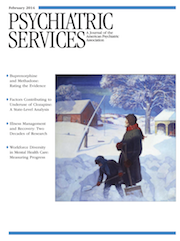Adherence to Oral Diabetes Medications Among Users and Nonusers of Antipsychotic Medication
Abstract
Objective
This study compared adherence to oral diabetes medications among users and nonusers of oral antipsychotic medications. Adherence to oral antidiabetics and antipsychotics among antipsychotic users was also compared.
Methods
Texas Medicaid prescription claims data from July 1, 2008, to December 31, 2011, were used to examine adherence to oral antidiabetics among users and nonusers of antipsychotics for 12 months after the first prescription for oral diabetes medication. Users and nonusers of antipsychotics were matched on the basis of their chronic disease score (CDS). Medication adherence was measured by proportion of days covered (PDC), and patients with a PDC value ≥.80 were considered to be adherent. Bivariate and multivariate analyses were used to compare adherence between cohorts.
Results
A total of 1,821 patients from each group were matched. The mean PDC for oral antidiabetics was significantly higher among antipsychotic users (.63) than nonusers (.55) (p<.001). About 37% (N=678) of antipsychotic users and 24% (N=473) of nonusers were adherent to oral antidiabetics. After adjustment for age, gender, CDS, and number of prescriptions, antipsychotic users were 2.10 times more likely than nonusers to be adherent to oral antidiabetics (p<.001). Antipsychotic users had higher mean PDC values for antipsychotic medications than for oral antidiabetics (.78±.25 versus .63±.29, p<.001).
Conclusions
Adherence to oral antidiabetics in the Texas Medicaid population was better among antipsychotic medication users than nonusers, but overall adherence was poor for both groups. Low adherence rates highlight the need for interventions to help improve medication management.



